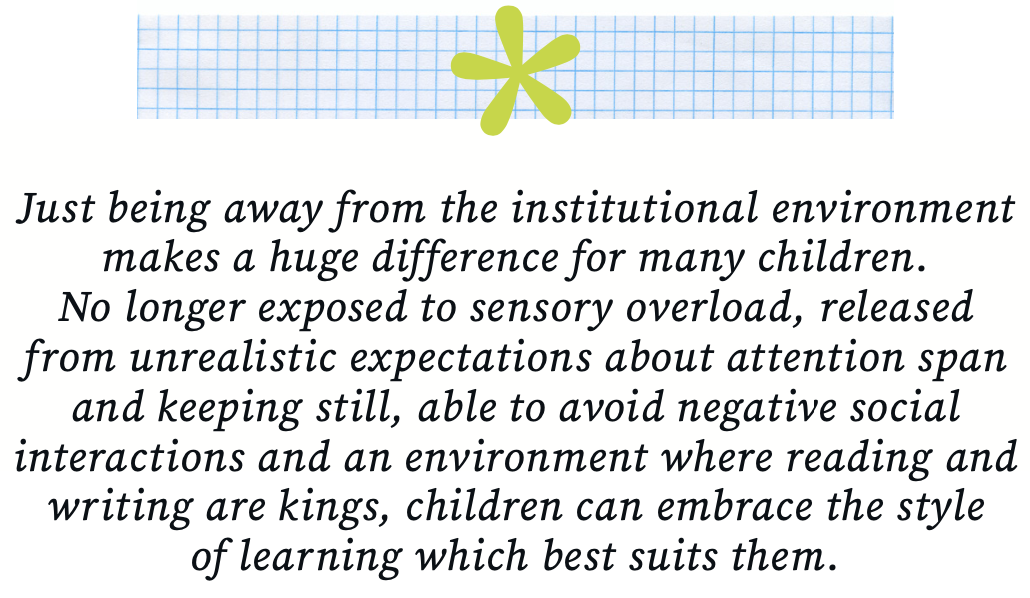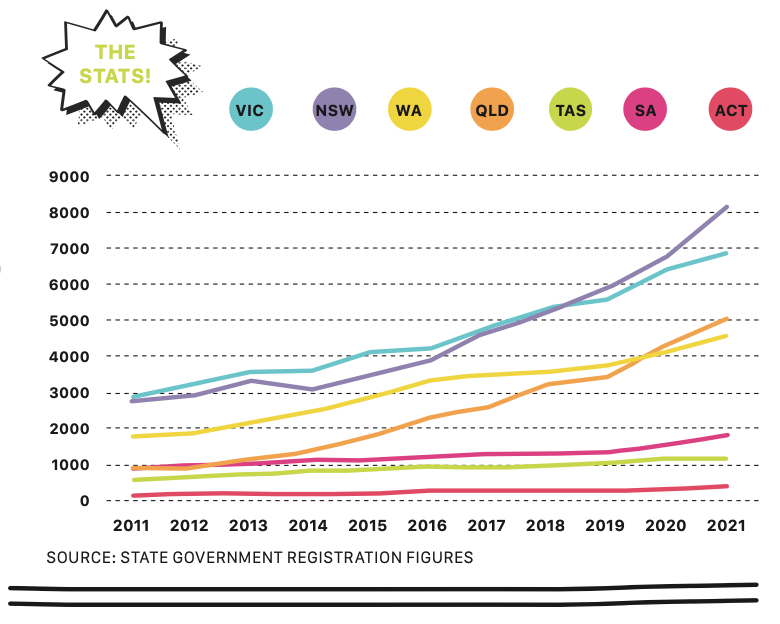
Could homeschooling be right for your family?
By Kirsty James
Homeschooling, or home education, has steadily grown in popularity over the past decade. But since COVID, parents are leaving mainstream schools in huge numbers and many neurodiverse, children with chronic illnesses and disabilities are finding a better fit outside the traditional education model, writes Kirsty James, Assistant Coordinator of The Home Education Network (HEN).
When asked to describe homeschooling, many people think of remote learning as experienced during the pandemic, or will mention outback kids doing distance education, or fall back on the stereotype of faith-based home educators with large families sitting at neat desks whilst mum points at a blackboard. In Australia, many people prefer the term ‘home education’ as it’s a better reflection of what we do.
Home education looks different for every family, but it allows true individualisation of learning. Rules vary by state, but adherence to the standard curriculum
is often not required, allowing children to pursue interest-based learning. For some children, this might look similar to school, for others it might be practical and hands-on, and for some, all learning will be self-directed (often called unschooling or natural learning) with parents primarily taking on the role of facilitator.
There has been a huge rise in the popularity of home education in Australia over the last decade. The internet has been a boon, allowing families to research, connect and access support more easily. Every year the Home Education Network (HEN) conducts a national survey of its members, covering a variety of topics.
Last year, “a happy family”, “a tailored education”, “school problems” and “specific learning needs” were the most common reasons families gave for their decision to home educate.
The survey found at least one third of families had one or more children with a disability, health condition or diverse learning need. The 2022 survey aims to gather more data about this cohort of families, but anecdotally, autism, anxiety, ADHD, dyslexia and intellectual disability are particularly common in the home ed community.
The pandemic saw a new influx of families. Some parents realised how much better their children were learning at home, or noted less anxiety or fewer
meltdowns. Others saw for the first time how disengaged their children were from their learning, or how unsuited the work was to their abilities. The increased amount of time at home also allowed many children to pursue hobbies, learn new skills, play games, bond with siblings and just ‘be children’. Early mornings, uncomfortable uniforms, and the rush to be at the school gate on time cause significant stress for some children, and with those expectations removed, and a more gentle schedule, many thrived.
EMBRACING SENSORY AND DIVERSE LEARNING NEEDS Unlike the school system, where neurodiversity and atypical learning styles are often considered problems to be solved, home education offers families the opportunity to choose an educational experience where children can focus on their strengths, experience success, and build self-confidence. Support can be provided in areas where extra help is needed, but need not be the focus, allowing more time for interest-led learning.
Just being away from the institutional environment makes a huge difference for many children. No longer exposed to sensory overload in the classroom and playground, released from unrealistic expectations about attention span and keeping still, avoiding negative social interactions, and instead being in an environment where reading and writing are kings, children can embrace the style of learning which best suits them. Mainstream schools and teachers are not always equipped or funded to manage children whose needs vary significantly from the norm, leading to some children being blamed for behaviour that is outside their control.

YOU CHOOSE WHAT WORKS FOR YOUR FAMILY
Home education provides the flexibility to structure our own day, to banish unnecessary ‘busy work’, and to embrace learning at any time, in any way. For
those with conditions that involve fatigue, pain, or concentration lapses, being able to take a break for a day, week, or month is vital. If multiple appointments and therapies are needed, these can be worked into the child’s schedule, and used to help meet the education requirements for each state. There’s no set timetable for home education, so we can grasp opportunities as they arise, and step back when it’s clear that the timing is wrong. Learning can be arranged in short blocks, with long breaks, or allowed to continue unhindered by bells and external expectations during periods where children are focused and engaged.
THE FINANCIAL COMMITMENT
Most parents moving out of the school system have concerns about how home education will work for their family, and for parents of children with additional needs, there are extra worries.
Financially, home education requires a level of sacrifice for many families, as it may mean the loss of one income. However, there are many families on low incomes, single parents, parents on a pension, or two parent families combining part-time work or working from home. Home educators are not paid, but registered home educating parents are exempt from the Centrelink mutual obligation requirement, and qualifying children can also receive the Assistance for Isolated Children payment, which is around $4000 per year. Home education does not need to be expensive and there are many free and inexpensive curriculum products. Families with more than one child can reuse materials, and it’s common for children of different ages to work together. THE BIGGEST WORRY FOR MANY PARENTS IS HOW THEY WILL TEACH THEIR CHILD Parents may not have tertiary qualifications, or feel confident about teaching all the subjects that would be encountered in school. However, the reality of home education is that children are more invested in their own learning, because it can be made relevant to them. Most children learn independently to some degree, with parents facilitating by finding resources and support. We have the right to decide what’s important or necessary for each child, which may look very different to the school curriculum. We also have the ability to outsource teaching to family members, friends or tutors, if necessary.
In the 2021 HEN survey, parents reported that their initial level of structure was around 60 per cent, and experience shows that most families complete their structured learning in one to three hours per day, leaving plenty of time for unstructured learning. The survey results also showed that as parents become more experienced, the level of structure falls to around 40 per cent. Many parents find themselves learning alongside their child, or from them. There’s no pressure to know all the answers, and acknowledging that we don’t know something, then showing the child how to find the answer, is valuable learning in itself.


WHAT ABOUT FURTHER STUDY?
Many families starting out also have concerns about how their children will access tertiary education or work. Home educated students have attended every university in Australia, and due to the opportunity to focus on areas of interest, they often move into tertiary education at an earlier age than their schooled peers. TAFE entry usually requires an assessment of English and maths skills, often at a level achievable for many who would struggle with standard Year 11-12 schooling.
Home educated students also have many opportunities to volunteer, undertake paid work, or do work experience, giving them well-rounded experience and interesting resumes.
SOCIAL INTERACTIONS
The home education community is warm and welcoming, and we commonly share resources and skills. We also get together regularly for educational and social excursions and meet ups providing an additional level of support for new parents. Our community is extremely diverse, and because we choose to focus on what we have in common, rather than on our differences, there is very little bullying or negative social pressure. Children are far more accepting of those who appear or act differently, than their schooled peers may be. Socialisation is similar to that of adults, in that children connect over shared interests and feel no need to belittle others. Many get-togethers will be at a local park, but there are also sports, dance and drama sessions, camps (which children attend with their family), art classes, theatre and museum visits, cooperative learning groups, virtual excursions and home ed gaming groups. Anyone can start a group, arrange a class, or invite others
to join them for an activity, and Facebook has made these kinds of connections much easier.


AN ALTERNATE OPTION
School works for some children, and not for others. In order for the school system to function, the focus can sometimes seem to be more about encouraging and supporting children with disabilities or learning differences to change, than it is on changing the system. If your child is a square peg, who is being pushed into a round hole instead of having their ‘squareness’ embraced, then home education might be a good fit for you.
If your child cannot, or will not, ‘fit in’, then maybe it’s time to find a place where individuality and quirks are considered the norm.
DO YOUR RESEARCH FIRST
If you are interested in exploring home education as an option for your child, it’s important to do some research. Find out the rules in your state, connect with local parents, and ensure that you get advice and support from people and organisations with no vested interest in selling you a product.
DESCHOOLING
One of the biggest predictors for successful home education is deschooling – the process of moving from thinking of education as it relates to school, to seeing education as part of life. For students, it’s about ensuring there is a transition period where they have the time and freedom to rediscover a love of learning,
to work out what they want and need to know, and how they can best achieve that. Without this transition, home education may simply replicate many of the issues encountered at school. It’s important to acknowledge that like every other aspect of home ed, deschooling will be different for every family. It’s important to note
that deschooling is just as necessary for the parent. It involves questioning the value of testing, being forced to learn things which are not relevant or interesting, requiring written ‘proof’ of learning and so on. Time spent considering your own schooling, and its relevance to your life can be very helpful. Most of us have forgotten the majority of our school studies, and find skills obtained outside school far more important. Conversely, we often retain feelings of shame, inadequacy and self- doubt linked to seeds planted at school.
Home education is different to school learning, it allows children ownership of their own learning, and removes unnecessary comparison and competition that leads students (particularly those who are already ‘different’ in some way) to feel ‘less than’. Home education replaces the rhetoric of individualised learning with a truly personalised experience. Home education is freedom!
——-
Kirsty James is Assistant Coordinator of The Home Education Network (HEN), a volunteer-run support organisation for home education families. Based in Victoria, HEN provides support and information to families across Australia. home-ed.vic.edu.au
Think homeschooling might be for you? Keep an eye out for our upcoming Facebook live with the HEN on Wednesday 18 January, 2023 at 7pm (AEST), 8pm (AEDT).
Read Rachel’s experience on homeschooling here.






